When it comes to mountain biking, control and comfort are non-negotiable. Every trail, every descent, and every technical section demands a fork that can handle the rigors of off-road riding while keeping you in command. Enter the Trifox 29er Disc Brake Tapered Carbon MTB Rigid Fork (Model TA-TMK100)—a game-changer for riders seeking to elevate their MTB experience. In this blog, we'll explore how this fork enhances control and comfort, making it a must-have upgrade for your mountain bike.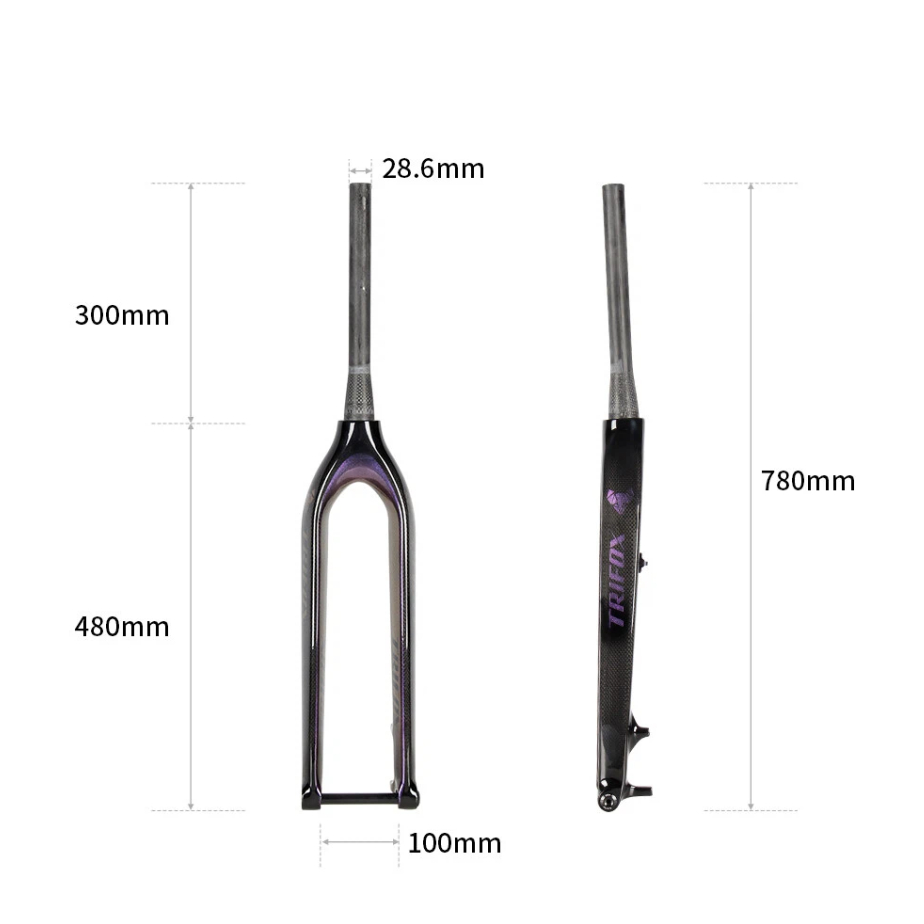
Lightweight Carbon Construction for Agile Handling
One of the standout features of this 29er carbon MTB fork is its full carbon fiber construction. Weighing just 600g, this fork significantly reduces bike weight for quicker steering response, easier maneuverability, and less fatigue on long rides. Whether navigating tight singletrack or climbing steep gradients, the reduced weight allows for more agile handling and better control—perfect for cross-country and trail riders who value speed and precision.
Tapered Design for Superior Stiffness and Stability
The tapered carbon fork features an engineered steerer tube that widens at the base to enhance steering precision and reduce flex. This design provides optimal stiffness during high-speed descents and aggressive cornering, giving riders confidence to tackle technical sections with predictable handling and improved stability.
29er Compatibility for Smooth Rollover and Traction
The 29-inch wheel compatibility of this 29er rigid fork ensures superior obstacle rollover, maintaining momentum and reducing bump impact. This results in a smoother ride with improved traction, directly translating to better control and comfort on rocky trails or loose gravel surfaces.
Disc Brake Compatibility for Reliable Stopping Power
Equipped with disc brake mounts, this ensures consistent, powerful braking in all conditions. The compatibility with modern hydraulic or mechanical disc brakes provides superior modulation and stopping power, crucial for maintaining control on steep descents and wet trails while ensuring rider safety.
Vibration Damping for a Comfortable Ride
Carbon fiber's natural vibration-damping properties make this carbon mountain bike fork exceptionally comfortable. By absorbing high-frequency trail vibrations, it reduces hand fatigue and discomfort, allowing for longer, more enjoyable rides—particularly beneficial on rough terrain where constant vibrations can cause numbness.

Sleek Design and Easy Installation
Beyond performance, the Trifox 29er Fork boasts a sleek, minimalist design that complements modern mountain bikes. Its gloss finish and clean lines add a touch of style to any build. Additionally, the fork is designed for easy installation, with compatibility for tapered head tubes and standard 100 * 15mm thru axles. Whether you’re upgrading an existing bike or building a new one, this fork is a straightforward and rewarding addition.
The Trifox 29er Disc Brake Tapered Carbon MTB Rigid Fork -TMK100 is a premium upgrade that delivers on both control and comfort. Its lightweight carbon construction, tapered design, and 29er compatibility work together to enhance your riding experience, while its vibration-damping properties ensure a smooth and comfortable ride. Whether you’re a competitive racer or a weekend warrior, this fork will help you tackle trails with confidence and style.
Ready to transform your mountain bike? Check out the Trifox 29er Carbon MTB Fork today and experience the difference for yourself!
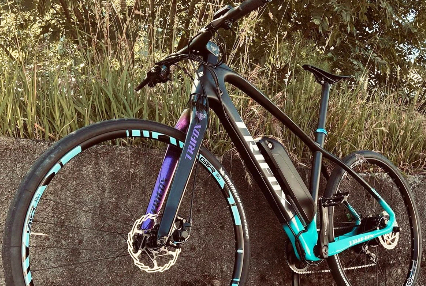
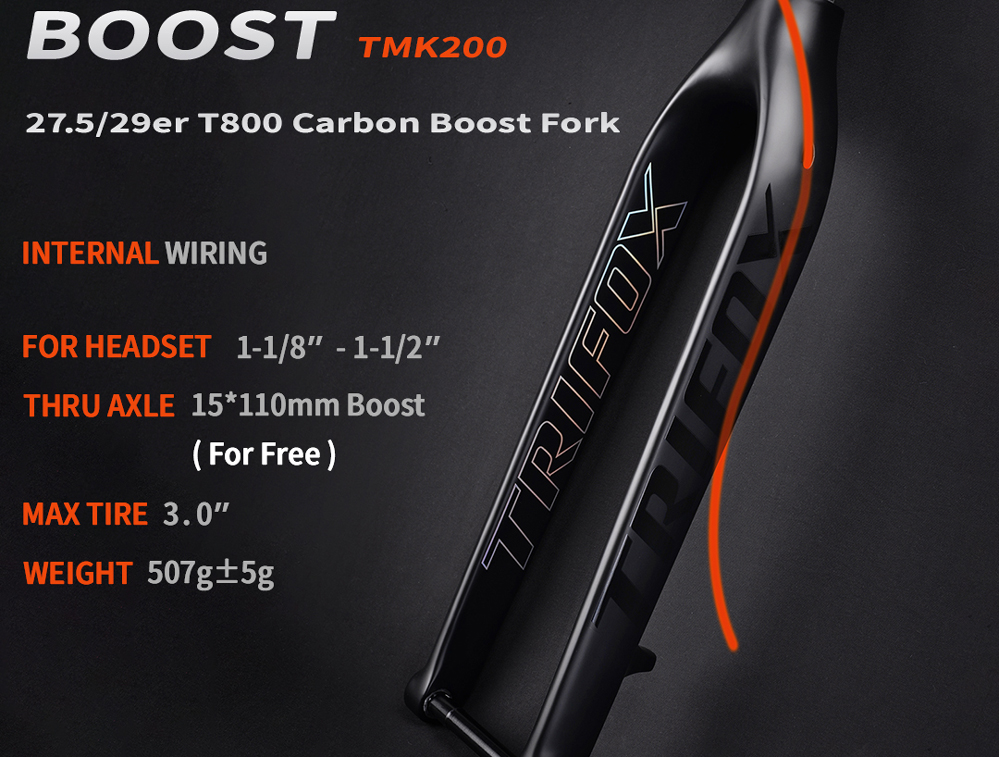
The 27.5" trail bike strikes a legendary balance: agile enough for tight corners, stable enough for chunk, and playful everywhere. But for years, a critical component often held them back – the fork. Enter high-modulus wonders like the Trifox T800 Carbon Boost Fork, fundamentally changing the game for 27.5" riders seeking pure trail performance.
The Weight Revolution:
Traditional alloy or lower-grade carbon forks add significant heft up front. T800 carbon fiber, renowned for its exceptional stiffness-to-weight ratio, slashes grams dramatically. Forks like the Trifox TMK200 tip the scales around a mere 450g. This unsprung weight reduction is transformative: your 27.5" bike becomes noticeably nimbler, accelerates faster, and flicks through technical sections with telepathic responsiveness. Climbing feels less of a chore as the front end stays light and precise.
Stiffness Meets Trail Agility:
Weight savings mean nothing without control. T800 carbon delivers incredible torsional and lateral stiffness. Paired precisely with the Boost 110x15mm thru-axle standard, this fork eliminates flex under hard cornering or braking. Your 27.5" wheels track exactly where you point them, inspiring confidence through loose berms and off-camber roots. Power transfer is direct, making every pedal stroke count. This stiffness isn't harsh; modern carbon layups absorb high-frequency trail buzz beautifully, enhancing control without sacrificing comfort on long descents.
Optimized for the Platform:
The 27.5" wheel thrives on quick handling and maneuverability. A rigid carbon fork like this amplifies those traits. Without suspension bobbing or diving, you get pure, unadulterated feedback from the trail. Steering input is immediate, fostering a deeply connected, "ride the tire" experience that sharpens skills and heightens fun. The tapered steerer tube ensures precise handling and integrates seamlessly with modern frames. Plus, the Boost spacing allows clearance for wider 27.5+ tires (often up to 2.8"), adding versatility for different terrains.
Durability & Simplicity:
文字
High-quality T800 carbon isn't just light and stiff; it's incredibly strong and fatigue-resistant. Rigid forks also ditch complex suspension components – no seals to service, no oil to change, no air springs to tune. It's maintenance simplicity defined, offering reliable performance ride after ride with minimal fuss. Disc brake specific (flat mount or post mount) ensures powerful, consistent stopping power.
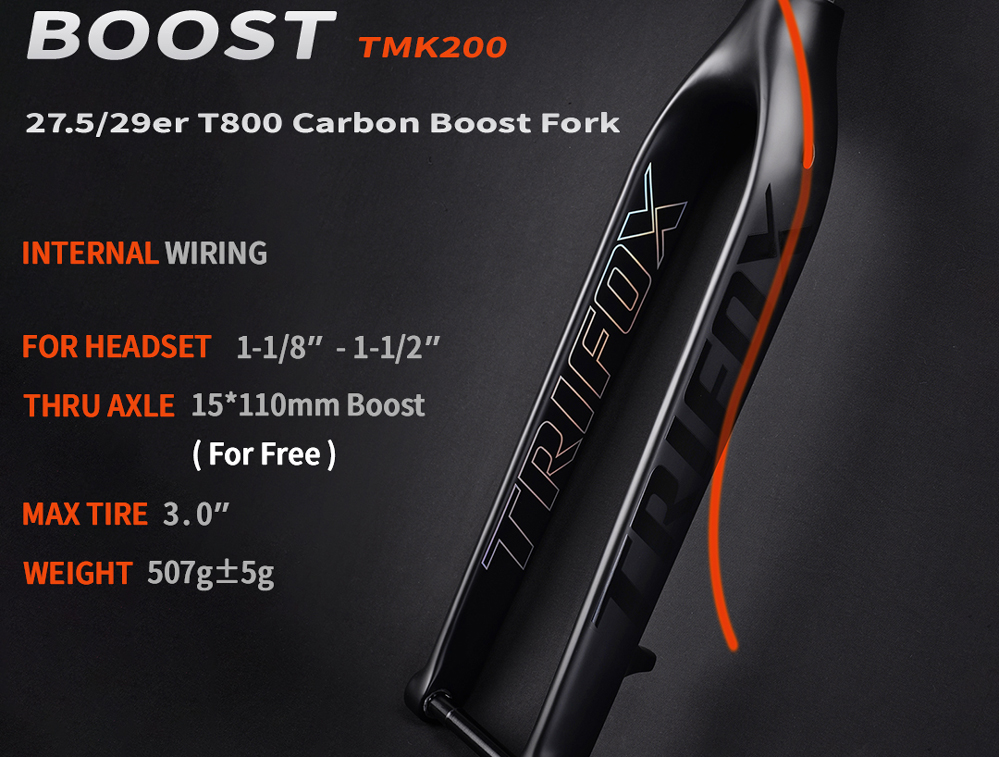
The Verdict:
For 27.5" trail riders prioritizing agility, efficiency, and a pure connection to the trail, the T800 Carbon Boost fork isn't just an upgrade; it's a revelation. It unlocks the platform's inherent playfulness by shedding weight, boosting stiffness, and delivering unmatched precision. If you crave a more responsive, lively, and engaging ride from your 27.5" steed, this technology is the key. It transforms your bike into a sharper, faster, and more rewarding partner on every trail.

In a world dominated by full-suspension mountain bikes and plush gravel rigs, rigid frames and forks might seem outdated. Yet, for many riders and disciplines, rigid suspension (i.e., no suspension at all) offers compelling advantages. Here’s why going rigid could transform your ride:
1. Unmatched Efficiency:
Every bump absorbed by suspension saps pedaling energy. Rigid bikes convert 100% of your power into forward motion. This makes them ideal for climbing, smooth trails, gravel roads, or urban commuting where speed and efficiency trump impact absorption.
2. Lighter Weight:
Eliminating shocks, springs, and pivots slashes weight significantly. A lighter bike accelerates faster, feels nimbler, and is easier to carry – a major perk for bikepacking, cyclocross, or long-distance riders.
3. Lower Maintenance & Cost:
No suspension means no seals to service, no air springs to tune, and no pivot bearings to replace. Rigid setups are simpler, cheaper to buy/maintain, and less prone to mechanical issues on long adventures.
4. Enhanced Direct Feel & Control:
Experience unparalleled connection to the trail. Rigid bikes offer instant feedback through the bars and saddle, allowing precise line choice, sharper cornering, and improved bike handling skills. You feel the terrain, fostering greater rider engagement.
5. Increased Frame Stiffness & Compatibility:
Without suspension constraints, frames can be designed for optimal stiffness and weight distribution. Rigid forks also simplify compatibility with any wheel size, tire width, or braking system (rim or disc).
6. Better Power Transfer:
No suspension bob means power surges – sprints or steep climbs – transfer directly to the rear wheel without energy loss. This responsive feel is cherished by racers and performance-focused riders.
Where Rigid Reigns Supreme:
Gravel & Road Riding: Efficiency and speed rule.
Smooth Singletrack/Hardpack: Where precision trumps plushness.
Commuting/Touring: Reliability and low maintenance win.
Cyclocross: Lightweight agility is critical.
Bikepacking: Weight savings and durability matter most.
The Trade-Off:
Rigid isn't for everyone. On technical, rocky, or rooty terrain, suspension smooths impacts and reduces fatigue. Your hands, arms, and back absorb more vibration.
Maximizing Rigid Comfort:
Wider Tires: Run lower pressures (within safe limits) for natural cushioning.
Compliance Tuning: Look for carbon forks/frames designed to flex subtly.
Eronomic Touchpoints: Quality grips, a supportive saddle, and padded gloves help.
The Verdict:
Rigid suspension champions purity, efficiency, and connection. It rewards skilled riders with lightning-fast responses and liberates you from complex maintenance. If your terrain allows, embracing rigidity means rediscovering the joy of direct control and unadulterated speed. It’s not about rejecting suspension; it’s about choosing the right tool for your ride.
Ready to simplify? A rigid bike might redefine "smooth" for you.
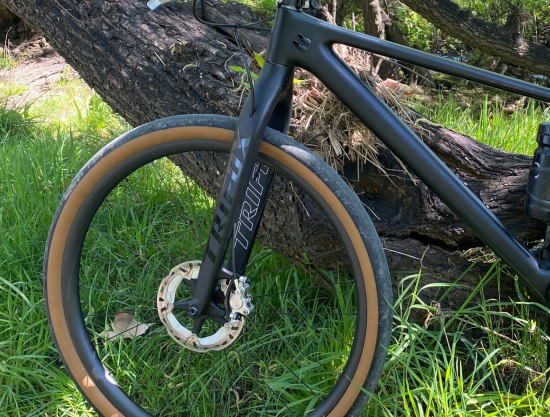
Does your front end feel vague or flex excessively when you really push it? That "noodle fork" sensation – steering wandering under hard cornering, brake shudder, or a general lack of precision – can be unnerving and slow you down. While some flex is inherent and even desirable for small bump compliance, excessive flex hurts control. Here's how to dial in more stiffness:
1. Increase Air Pressure (Air Forks Only): The simplest and most direct adjustment. Adding air pressure compresses the air spring more, requiring more force to initiate movement. This significantly increases the overall stiffness of the fork, especially resisting large impacts and big compressions that cause flex. Crucially: Stay within the manufacturer's recommended maximum pressure (usually printed on the fork leg). Exceeding it risks seal failure or even catastrophic damage. Start with 5-10 PSI increases, test ride, and repeat cautiously.
2. Add Volume Spacers (Air Forks Only): These small plastic tokens fit inside the air spring chamber. They reduce the air volume. Why does this help stiffness? With less volume, the air pressure ramps up much more aggressively deeper into the fork's travel. This primarily increases mid-to-end stroke support. While not directly stiffening the initial feel like pure pressure, it combats the deep dive that often feels like flex under heavy braking or big G-outs, making the fork feel more supportive and planted overall.
3. Adjust Compression Damping:
- Low-Speed Compression (LSC): Found on most mid-to-high-end forks. This controls the fork's resistance to slow, deliberate movements like braking, cornering, and pedaling forces. Increasing LSC adds significant resistance to these forces, directly combating brake dive and the flex/wander feeling during hard cornering. Turn the dial clockwise (usually) a click or two at a time and test.
- High-Speed Compression (HSC): Less common, controls resistance to sharp, fast impacts (rocks, roots). While primarily for tuning big-hit harshness, a slight increase might offer a subtle perception of firmness, but focus on LSC first for stiffness related to steering inputs.
4. Increase Oil Viscosity (Advanced): Fork oil lubricates and dampens. Thicker oil (higher viscosity, e.g., going from 5wt to 7.5wt or 10wt) creates more resistance inside the damper. This makes the damper cartridge stiffer, particularly the compression circuit, requiring more force to move the fork quickly. This is an advanced modification. Research your specific fork model thoroughly – using oil that's too thick can damage internals, make the fork harsh, and void warranties. Best done during a full service.
5. Service Your Fork: Worn bushings, contaminated oil, or degraded seals introduce slop and reduce the fork's ability to move smoothly in its intended path. This often manifests as play or a vague, "sticky" flex feeling. A full lower leg service (replacing oil, seals, and bushings if needed) restores the fork's tightness and responsiveness, eliminating unwanted movement that feels like flex.

Important Considerations:
- Trial & Error: Stiffness preferences are personal. Make one change at a time and test thoroughly on familiar terrain.
- Trade-offs: Increasing stiffness almost always reduces small-bump sensitivity and plushness. Find the right balance for your riding style and terrain.
- Fork Limits: Every fork has a design stiffness. Aggressive riders on lightweight XC forks will hit limits faster than someone on a burly enduro fork. If you've maxed out adjustments and servicing, a stiffer chassis might be the ultimate solution.
- Headset Check: Ensure your headset is properly preloaded. A loose headset feels like fork flex!
By methodically working through these adjustments – starting with air pressure/volume and compression damping – you can significantly reduce unwanted flex and gain the precise, confident front end your aggressive riding demands.
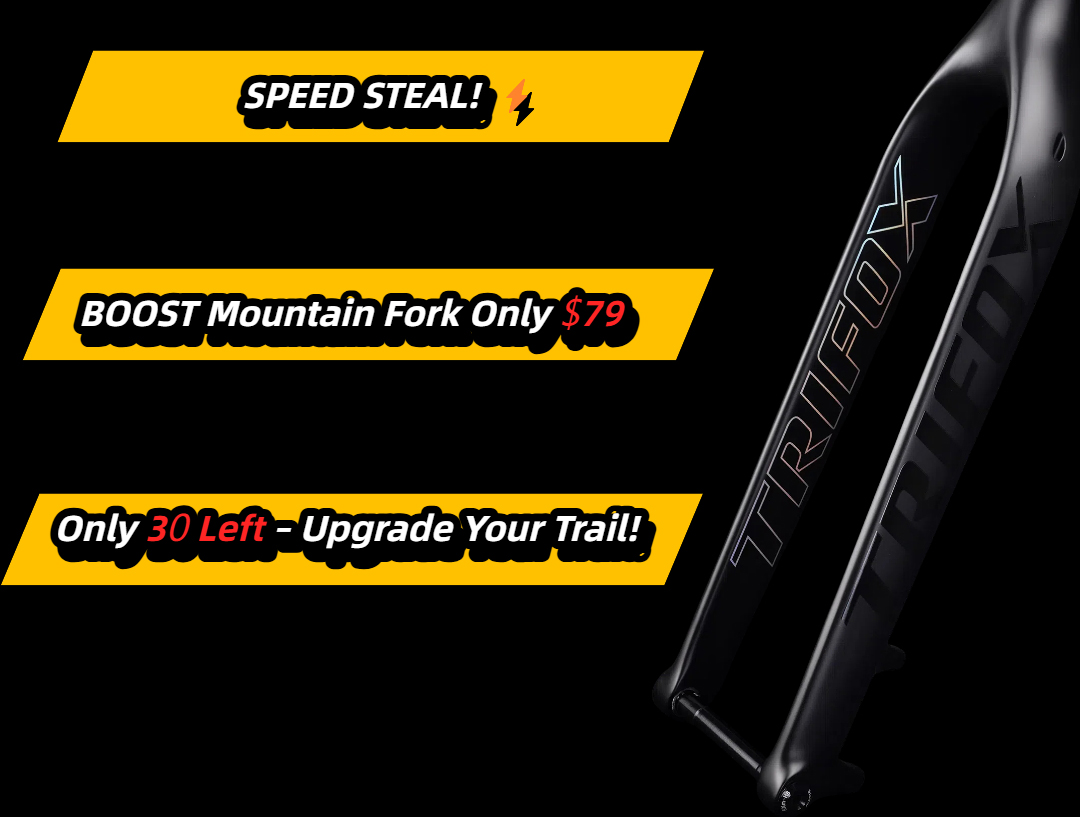
For mountain bikers, a carbon fork is a game-changer—offering lightweight performance, vibration-damping comfort, and razor-sharp steering precision. But high costs often put these upgrades out of reach… until now.
Carbon fiber’s magic lies in its blend of strength and featherlight weight. Unlike alloy forks, carbon absorbs trail chatter, reducing arm fatigue on rough terrain while maintaining stiffness for confident handling. Perfect for cross-country riders, commuters, or gravel adventurers seeking speed and comfort.
What Makes the Trifox Fork a Steal?
- Boost Spacing: Compatible with modern 29” MTB wheels (110x15mm axle), this fork ensures better tire clearance and stiffness for aggressive riding.
- Disc Brake Ready: Designed for flat-mount disc brakes, it delivers reliable stopping power in all conditions.
- Tapered Steerer: Enhances steering precision and durability, fitting most contemporary bike frames.
- Rigid Design: Ditch the weight and maintenance of suspension forks—ideal for riders prioritizing efficiency over rough terrain.
Who Should Upgrade?
- Budget-Conscious MTBers: Replace a heavy stock fork or upgrade an older hardtail without splurging.
- Gravel & Commuter Riders: Add carbon’s comfort to mixed-surface adventures or daily rides.
- DIY Builders: A cost-effective cornerstone for building a lightweight, high-performance rig.

Carbon forks at this price point are rare—and Trifox’s offering delivers core benefits without cutting corners. Whether you’re chasing PRs on singletrack or smoothing out city streets, this fork proves premium upgrades don’t have to break the bank.

As mountain biking technology evolves, riders demand forks that balance lightweight agility with unshakable stiffness and control. Enter the Trifox TMK200 29er Carbon Rigid Fork—a standout contender for 2025's top Boost-compatible forks. Designed for riders who prioritize precision and durability, this fork redefines performance on rugged trails. Here’s why it’s a must-have upgrade for your MTB setup.
1. Boost Spacing: The Stiffness Revolution
The TMK200 embraces 148x12mm Boost hub spacing, a standard that’s become non-negotiable for modern MTBs. By widening the hub flange distance, Boost spacing increases wheel stiffness, reducing flex during hard cornering or high-load descents. This translates to sharper steering response and better power transfer, especially on technical terrain. Paired with a rigid carbon construction, the TMK200 eliminates energy-sucking flex, letting you tackle rock gardens and drop-offs with confidence.
2. Carbon Fiber Mastery
Crafted from high-modulus T800 carbon fiber, the TMK200 sheds weight without sacrificing strength. At roughly 450g, it’s significantly lighter than aluminum counterparts, yet stiffer laterally to prevent brake shudder and steering wander. Carbon’s natural vibration-damping properties also absorb trail chatter, reducing hand fatigue on long rides. Whether you’re racing XC or bikepacking, this fork ensures every watt of effort goes forward.
3. Tapered Steerer for Precision Handling
The 1.5” to 1.125” tapered steerer tube reinforces the fork’s crown junction, a critical stress point. This design enhances torsional rigidity, ensuring your handlebar inputs translate instantly to the front wheel. No more sluggish steering or “dead” feel—just razor-sharp control, whether you’re threading through tight singletrack or navigating rooty climbs.
4. Disc Brake Dominance
The TMK200 is built for modern flat-mount disc brakes, offering cleaner integration and superior stopping power. Its reinforced carbon legs handle heat dissipation efficiently, preventing brake fade on prolonged descents. The fork’s rigidity also minimizes brake-induced flex, maintaining consistent rotor alignment for reliable modulation in all conditions.
5. Future-Proof Versatility
Compatible with both 29er and 27.5+ wheels (up to 3.0” tires), the TMK200 adapts to your riding style. Its minimalist design supports minimalist builds—ideal for gravel riders or rigid MTB purists—while the internal cable routing option keeps your setup sleek. Plus, the Boost standard ensures compatibility with the latest hubs and wheelsets, protecting your investment as components evolve.
Why the Trifox TMK200 Stands Out in 2025
While suspension forks dominate headlines, rigid options like the TMK200 are gaining traction for their simplicity and direct trail feedback. Riders seeking a “connected” feel will appreciate its uncompromising stiffness, while weight-conscious racers benefit from its pared-down design. Add in corrosion resistance and a stealthy matte finish, and you’ve got a fork that’s as durable as it is performance-driven.
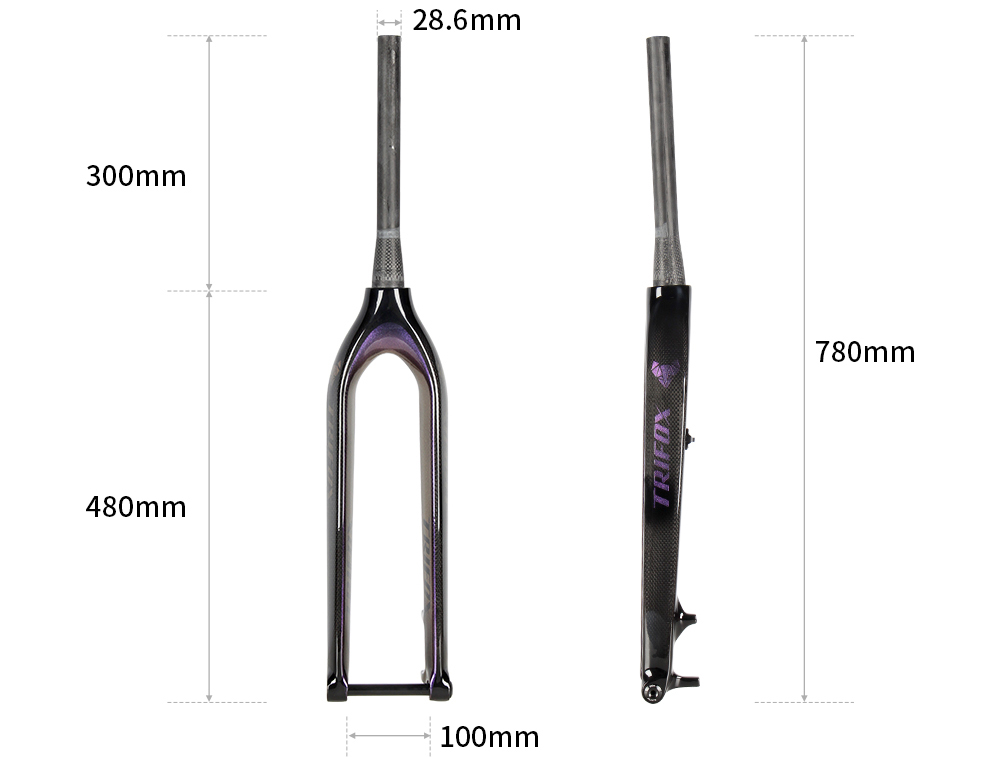
Upgrading your bike’s fork can transform its handling, weight, and performance. But before swapping parts, it’s crucial to know: not every fork fits every bike. Compatibility hinges on specific standards, and ignoring them can lead to costly mistakes. Let’s break down what matters—and how rigid forks like Trifoxbike’s Carbon Rigid Forks fit into the equation.
Key Factors in Fork Compatibility
1. Axle Standards:
Forks are designed for specific axle types (e.g., QR, thru-axle). A 15x100mm thru-axle fork won’t fit a QR hub without adapters—if at all.
2. Steerer Tube Diameter & Length:
Most road bikes use 1⅛” steerers, while MTBs may use tapered (1.5” to 1⅛”). Measure your headset’s specs before buying.
3. Brake Compatibility:
Disc brake forks require mounts (Post Mount or IS); rim brake forks need caliper bosses. Mixing systems rarely works.
4. Wheel Size:
A 29” MTB fork won’t suit a 27.5” wheel, and road forks are built for 700c. Always match the fork to your wheel diameter.
5. Suspension vs. Rigid:
Suspension forks add complexity (travel, crown height). Rigid forks, like Trifoxbike’s carbon options, simplify compatibility but demand precise geometry.
Why Rigid Forks Are a Safe(ish) Bet
Rigid forks eliminate suspension-related variables, making them easier to fit—if axle, steerer, and brake standards align. For example, Trifoxbike’s Carbon Rigid Forks come in multiple configurations (QR/thru-axle, disc/rim brake) to suit gravel, MTB, or hybrid builds. Their lightweight carbon design also reduces weight while maintaining stiffness, ideal for riders prioritizing efficiency over suspension.
When to Consider a Rigid Fork
- Weight Savings: Carbon rigid forks can cut 1–2 lbs vs. suspension.
- Simplified Maintenance: No seals or stanchions to service.
- Compatibility Control: Easier to match axle/brake standards.
The Exceptions
Even rigid forks aren't universal. A cyclocross fork might lack clearance for MTB tires, and a road fork’s rake (offset) could destabilize a gravel bike. Always cross-check:
- Tire Clearance: Does the fork fit your tire width?
- Rake/Offset: Affects handling; match your bike's original specs.
Final Tips
1. Measure twice: Confirm steerer diameter, axle type, and brake mounts.
2. Prioritize purpose: Use MTB forks for MTBs, road forks for road bikes.
3. Check geometry: A fork's axle-to-crown length impacts ride height and steering.

The Bottom Line
While no fork fits every bike, rigid options like Trifoxbike’s carbon models simplify compatibility with versatile standards. Pair them with precise measurements, and you’ll unlock a lighter, nimbler ride—without the headache of mismatched parts.
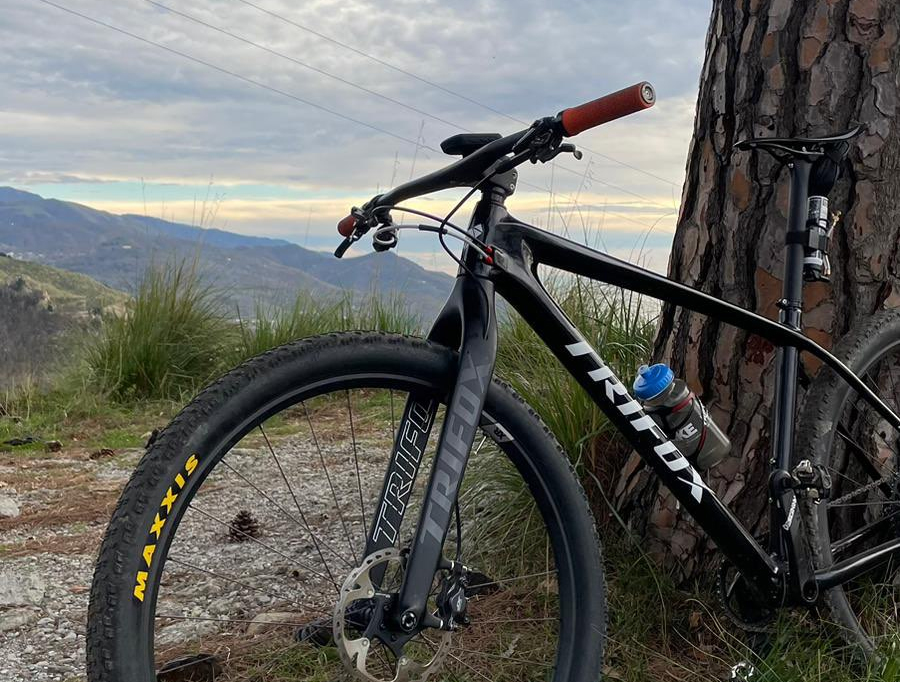
In the world of mountain biking, agility reigns supreme. Whether carving through singletrack or tackling technical descents, responsiveness and control define your ride.
The secret to unlocking next-level off-road performance lies in two innovations: an ultralight carbon MTB frame and a Boost fork. Together, they create a synergy that elevates speed, precision, and confidence on any trail.
Ultralight Carbon Frame: The Backbone of Speed
Carbon fiber's magic lies in its strength-to-weight ratio. Trifox’s SDY20 frame exemplifies this, shedding grams without sacrificing durability. A lighter bike accelerates faster, climbs easier, and flicks through tight turns effortlessly. Carbon’s natural vibration damping also enhances comfort, reducing fatigue on long rides. But the real win is stiffness—optimal torsional rigidity ensures every watt of power translates to forward motion, while compliant seatstays absorb trail chatter for better traction.
Boost Fork: Precision Meets Stability
The Boost standard (110mm front axle spacing) isn’t just a buzzword—it’s a game-changer. Wider hub spacing increases wheel stiffness, preventing flex during hard cornering or rock strikes. This means sharper steering response and unwavering control in loose terrain. Paired with a lightweight carbon frame, the Boost fork ensures your front wheel tracks true, boosting confidence on steep descents and technical climbs.
The Dynamic Duo
Combine the SDY20's featherlight frame with a Boost fork, and agility reaches new heights. The frame's nimble character complements the fork’s stability, creating a bike that’s both quick and composed. Tight switchbacks? Effortless. Rocky descents? Unshakable. This pairing reduces rider fatigue, letting you push harder for longer.
For riders seeking an edge, Trifox’s SDY20 merges cutting-edge materials and smart engineering. It's not just about weight or stiffness—it’s how these elements harmonize to redefine off-road agility.

Choosing the right mountain bike fork can make or break your ride. With so many options—rigid, suspension, air-sprung, coil-sprung—it’s easy to feel overwhelmed. But don’t worry! We’re breaking down the most common MTB fork types and how they align with different riding styles.
1. Rigid Forks: Simplicity Meets Lightweight
Rigid forks (no suspension) are ultralight and low-maintenance, ideal for smooth trails, gravel paths, or bikepacking where weight savings matter most. They’re perfect for cross-country purists or riders prioritizing efficiency over comfort. However, they lack shock absorption, making them less suitable for technical terrain.
2. Hardtail Suspension Forks: Versatility on a Budget
Hardtail forks (front suspension only) strike a balance between efficiency and control. Air-sprung models (like Trifox’s carbon suspension forks) are lightweight and adjustable, ideal for trail riding or XC racing. Coil-sprung forks, while heavier, offer plush performance for all-day endurance rides.
3. Full Suspension Forks: Conquer the Gnar
Paired with a rear shock, full suspension forks soak up bumps on aggressive descents. Look for forks with 150–180mm of travel for enduro or downhill riding. Features like adjustable damping and lockouts (available in premium models) let you switch between climbing efficiency and downhill stability.
4. Hybrid Forks: The Best of Both Worlds?
Some forks blend air and coil springs for tunable performance. These hybrids cater to all-mountain riders who tackle mixed terrain. They’re adaptable but often come at a higher price point.
Key Considerations
Travel: Match fork travel to your terrain (80–120mm for XC, 130–150mm for trail, 150mm+ for enduro/downhill).
Weight: Carbon forks (like Trifox’s) reduce weight without sacrificing strength—critical for climbing.
Axle Standards: Boost spacing (110x15mm) improves stiffness and tire clearance.
Budget: High-end forks offer adjustability, but mid-range models can still deliver great performance.
Why Carbon Forks?
Carbon fiber forks, such as those from Trifox Bike, combine durability with vibration damping—key for long rides. They're also corrosion-resistant and excel in stiffness-to-weight ratios, making them a favorite among competitive riders.

Your fork choice depends on where and how you ride. For XC racers, a lightweight air-sprung carbon fork is ideal. Trail riders benefit from adjustable 120–140mm travel, while enduro shredders need burly 150mm+ forks. Check out Trifox Bike’s carbon forks to find a high-performance option tailored to your style.


























































